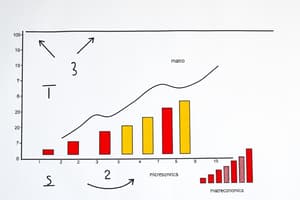Podcast
Questions and Answers
What is the main benefit of trade between countries?
What is the main benefit of trade between countries?
- Isolation from global markets
- Reduction of currency values
- Increased tariffs on imported goods
- Comparative advantage (correct)
How do exchange rates impact international trade?
How do exchange rates impact international trade?
- They determine the value of goods traded. (correct)
- They only affect domestic markets.
- They have no effect on investment decisions.
- They eliminate the need for trade agreements.
What does economic development primarily focus on?
What does economic development primarily focus on?
- Reducing public goods
- Promoting trade barriers
- Improving citizens' well-being (correct)
- Facilitating market failures
What is a market failure?
What is a market failure?
What characterizes public goods?
What characterizes public goods?
What term describes the cost of the next best alternative forgone when making a decision?
What term describes the cost of the next best alternative forgone when making a decision?
Which of the following is a characteristic of a monopoly?
Which of the following is a characteristic of a monopoly?
What does GDP measure?
What does GDP measure?
Which economic theory advocates for government intervention during economic cycles?
Which economic theory advocates for government intervention during economic cycles?
What is the primary focus of microeconomics?
What is the primary focus of microeconomics?
What is an indicator of the percentage of the labor force that is jobless and actively seeking employment?
What is an indicator of the percentage of the labor force that is jobless and actively seeking employment?
In which market structure do few large sellers dominate and have interdependent pricing?
In which market structure do few large sellers dominate and have interdependent pricing?
How does the law of demand describe the relationship between price and quantity demanded?
How does the law of demand describe the relationship between price and quantity demanded?
Flashcards are hidden until you start studying
Study Notes
Key Concepts in Economics
-
Definition of Economics: The study of how individuals, businesses, and governments allocate scarce resources.
-
Branches of Economics:
- Microeconomics: Focuses on individual agents and markets; studies supply and demand, price determination, and consumer behavior.
- Macroeconomics: Studies the economy as a whole; examines aggregate indicators such as GDP, unemployment rates, inflation, and national policies.
Fundamental Economic Principles
- Scarcity: Limited resources versus unlimited wants; drives choice and trade-offs.
- Opportunity Cost: The cost of the next best alternative forgone when making a decision.
- Supply and Demand:
- Law of Demand: As price decreases, demand increases, and vice versa.
- Law of Supply: As price increases, supply increases, and vice versa.
- Market Equilibrium: Point where supply and demand curves intersect; determines market price and quantity sold.
Market Structures
- Perfect Competition:
- Many buyers and sellers.
- Homogeneous products.
- No barriers to entry.
- Monopoly:
- Single seller dominates the market.
- High barriers to entry.
- Price maker, not price taker.
- Oligopoly:
- Few large sellers dominate.
- Interdependent pricing and output decisions.
- Monopolistic Competition:
- Many sellers.
- Differentiated products.
- Some degree of market power.
Economic Indicators
- Gross Domestic Product (GDP):
- Total value of all goods and services produced within a country's borders.
- Indicator of economic health and growth.
- Unemployment Rate: Percentage of the labor force that is jobless and actively seeking employment.
- Inflation Rate: Rate at which the general level of prices for goods and services rises, eroding purchasing power.
Government Involvement
- Fiscal Policy: Government adjusts spending and tax rates to influence the economy.
- Monetary Policy: Central bank controls the money supply and interest rates to stabilize the economy.
Major Economic Theories
- Classical Economics: Focuses on free markets, minimal government intervention, and believes in self-regulating markets.
- Keynesian Economics: Advocates for government intervention to manage economic cycles, particularly during recessions.
- Supply-Side Economics: Emphasizes boosting supply (production) to stimulate the economy, often through tax cuts.
Global Economics
- Trade: Exchange of goods and services between countries; benefits include comparative advantage.
- Exchange Rates: The value of one currency in relation to another; affects international trade and investment.
- Economic Development: The process by which countries improve the economic, political, and social well-being of their citizens.
Essential Terms
- Market Failure: When the allocation of goods and services is not efficient.
- Externality: A side effect or consequence of an economic activity that affects third parties.
- Public Goods: Goods that are non-excludable and non-rivalrous, such as national defense and public parks.
These notes cover essential concepts and frameworks that shape the study of economics, aiding in the understanding of how economies function and interact.
Definition of Economics
- Economics studies how people, businesses, and governments make decisions about scarce resources.
Branches of Economics
- Microeconomics focuses on individual actors and markets, like how prices are set and consumers react to them.
- Macroeconomics examines the big picture, like overall economic growth, unemployment, and national policies.
Fundamental Economic Principles
- Scarcity: There are limited resources but endless wants, which forces choices and trade-offs.
- Opportunity Cost: The value of the best alternative you give up when making a choice.
- Supply and Demand:
- Law of Demand: Higher prices lead to lower demand, and vice versa.
- Law of Supply: Higher prices lead to higher supply, and vice versa.
- Market Equilibrium: The point where supply and demand curves meet, determining price and quantity sold.
Market Structures
- Perfect Competition: Many businesses sell the same product with easy entry, leading to no individual control over prices.
- Monopoly: One company controls the entire market, setting prices with few restrictions.
- Oligopoly: A few large companies dominate, with their decisions impacting each other.
- Monopolistic Competition: Many businesses sell slightly different products, having some control over prices.
Economic Indicators
- Gross Domestic Product (GDP): The total value of goods and services produced within a country's borders, reflecting economic health and growth.
- Unemployment Rate: Percentage of the labor force actively seeking but not finding work, representing the health of the job market.
- Inflation Rate: Rate at which prices for goods and services increase, indicating potential loss of purchasing power.
Government Involvement
- Fiscal Policy: Governments use spending and taxes to influence the economy, like spending more during recessions to stimulate growth.
- Monetary Policy: Central banks manage the money supply and interest rates to stabilize the economy, like lowering rates to encourage borrowing and spending.
Major Economic Theories
- Classical Economics: Emphasizes free markets, minimal government interference, and the belief that markets naturally regulate themselves.
- Keynesian Economics: Advocates for active government intervention to manage economic ups and downs, especially during recessions.
- Supply-Side Economics: Focuses on increasing production by reducing taxes and regulations, believing this will create economic growth.
Global Economics
- Trade: Exchange of goods and services between nations, offering benefits like specialized production and lower prices.
- Exchange Rates: The value of one currency relative to another, impacting international trade and investment.
- Economic Development: The process nations use to improve their economic, political, and social well-being.
Essential Terms
- Market Failure: When resources aren't allocated efficiently, causing problems like pollution or lack of public services.
- Externality: Side effects of activities, like pollution from factories, that affect third parties.
- Public Goods: Goods that are available to everyone, even if they don't pay, like national defense or parks.
Studying That Suits You
Use AI to generate personalized quizzes and flashcards to suit your learning preferences.




